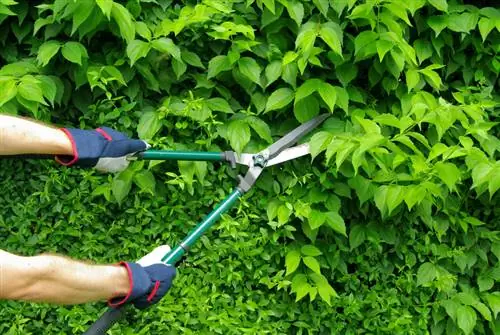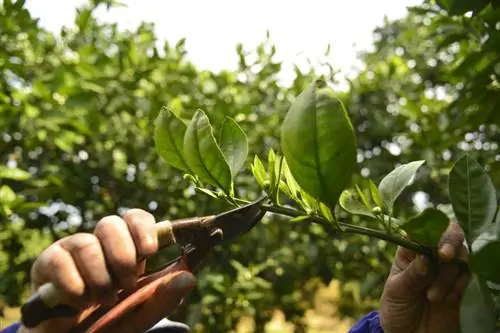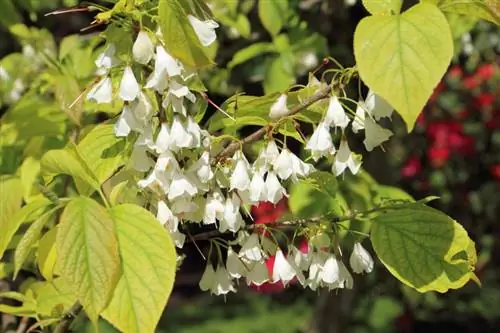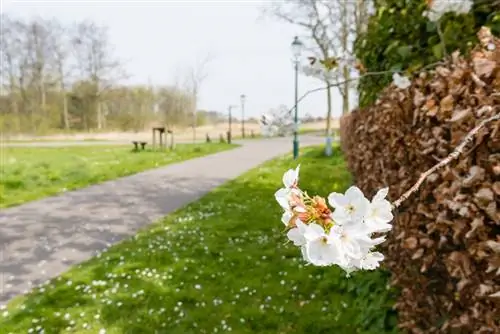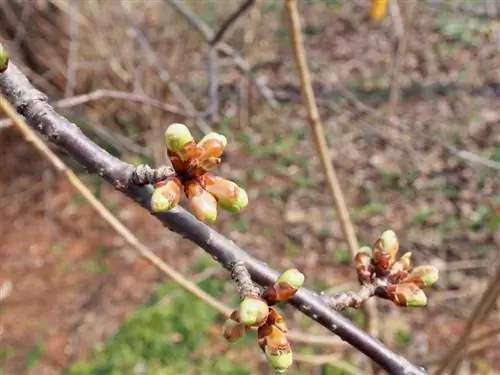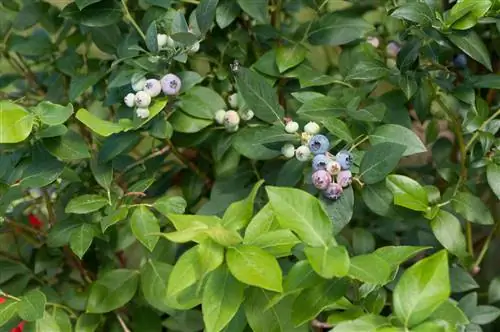- Author admin [email protected].
- Public 2023-12-24 06:09.
- Last modified 2025-06-01 06:02.
The native hornbeam impresses as a decorative deciduous tree with natural charm. Its advantages come into its own impressively as a solitary tree and densely leafy shrub. The cutting tolerance of Carpinus betulus is legendary and can be achieved even by an inexperienced hand. A wide range of imaginative design variants makes the hornbeam an important element of garden design if an easy-care and pruning-tolerant ornamental tree is on your wish list. This tutorial is full ofpractical instructions for pruning hornbeams as a tree, shrub and hedge.
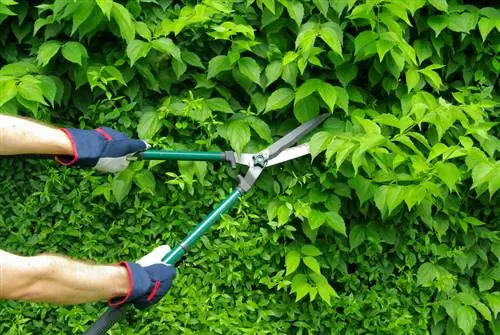
When should you cut the hornbeam?
Prune the hornbeam in late February before the closed season. Another possible time for pruning is early summer. If the hedge does lose its shape, just slightly shorten the new shoots.
Hornbeam - tolerant of many types of cutting
With a hornbeam, an undemanding and forgiving tree finds its way into the garden. The home advantage gives the deciduous tree arobust winter hardiness, which not least results in a pronouncedcutting tolerance. Hornbeams cooperate in training to become majesticdeciduous treesjust as conciliatory as when they are cultivated as decorativeshrubor formalhedgewith privacy function. To name all the artistic hornbeam varieties would go beyond the scope of this tutorial. The following overview presents popular, traditional and trendy cuts with information on the best times to cut:
| Type of cultivation | Cut style | Goal/Occasion | best date |
|---|---|---|---|
| Tree | Shaping and maintenance pruning | Shape and maintain crown | Late winter (end of November to end of February) |
| Tree | Rejuvenation cut | rejuvenate aged crown | Winter (November to February) |
| Shrub - solitary or small group | Build-up cut | stable and densely bushy growth | February |
| Shrub - solitary or small group | Blending cut | Remove dead wood, regulate growth | February and end of June |
| Hedge | Topiary and care pruning | opaque growth, well-groomed appearance | February and end of June |
| Shrub or hedge | Rejuvenation cut | revitalise aged hornbeams | Winter (November to February) |
In expert tree pruning, theideal timehas shifted from June toFebruary With the help of many years of field tests, experts have found that trees and shrubs are better respond to pruning in late winter. St. John's Day at the end of June remains the traditional pruning date for light care pruning of hedges and strong-growing shrubs.
Tip
The current expression Hanebüchen originally has a close connection to the rough, gnarled wood of a hornbeam. Over the centuries the expression has undergone a change in meaning. In modern usage, when we talk about an “outrageous mistake,” this means that the person in question has committed a gross misconduct. If you follow the instructions in this tutorial, you will at least be protected from “outrageous cutting errors”.
Tree pruning instructions - shape and maintenance pruning
Naturally, a hornbeam thrives as a medium-sized tree with a conical, later rounded, wide crown. As a free-growing house tree, the native tree species magnificently rounds off the natural garden design. Successful varieties such as 'Fastigiata' or 'Monumentalis', which are popular in small gardens and front gardens, delight with special crown shapes and compact growth.
A well-behaved hornbeam remains uncut in thefirst few years Only as it gets older is pruning at intervals of 4 to 5 years advisable. Thinning out dead wood and shaping the crown guarantee a well-groomed appearance and gentle growth control. How to properly prune a hornbeam as a free-growing tree:
- Thinning out the crown every 4 to 5 years
- Cutting off a dead branch on Astring
- Remove steeply upward growing, weak and inward-facing shoots
- Make each cut a few millimeters above an outward-facing bud
- Cut off trunk shoots growing below the crown without damaging the bark
- Tear out shoots of water or unwanted seedlings sprouting from the tree disc
If a branch that is too long protrudes from the crown, correct the aesthetic problem with a lead cut. The clever cutting technique prevents pruning from causing unsightly gaps in the crown. Don't just cut the branch in question just anywhere. Rather, look for a short, outward-facing side shoot near the intersection. At thefork of both shoots cut off the section that is too long. The side shoot, which was previously subordinate, will now take over the leading position without the cut affecting the harmonious crown appearance.

A free-growing hornbeam naturally forms a beautiful, rounded crown with a diameter of up to 12 meters. It is thinned out and trimmed every 4 to 5 years. Thin out dead wood and unfavorable branches on Astring. Branches that protrude out of shape lead you to a he althy side shoot. Shoots growing below the crown and from the tree disc are removed.
Rejuvenate old hornbeams - this is how it works
Uncut, the hornbeam forms a spacious crown with a diameter of 12 meters and beyond. A dense network of old, bare and young, stunted branches makes normal maintenance pruning impossible. Instead of clearing the neglected tree, bring the crown back to normal with a radical pruning. To make your hornbeam worthy of being called a house tree again, breathe new life into it with a rejuvenating pruning. How to cut correctly:
- The best time is during the leaf-free period from November to February
- First clear out all dead wood
- Select he althy, strong leading branches in a suitable number as the new crown
- Shorten selected leading branches by half by directing them to a young side shoot
- Saw off all remaining, aged leading branches on Astring
- Saw a branch in stages from arm thickness onwards
When making a rejuvenation cut, the hornbeam's strong pruning tolerance plays into your hands. You can rely on the tree to sprout freshly even from its old wood. The secret lies hidden in sleeping eyes that lie dormant beneath the bark for many years. The radical pruning acts like a wake-up call and activates the dormant buds. Depending on the overall condition of the hornbeam in question, vigorous growth sets in as the ideal starting point for rebuilding the crown.
As the illustration below shows, the rejuvenation cut leaves a stripped crown of central shoots with selected leading branches that bear a few, promising side shoots. You can cushion clear-cutting by diverting as many old branches as possible to young side branches.
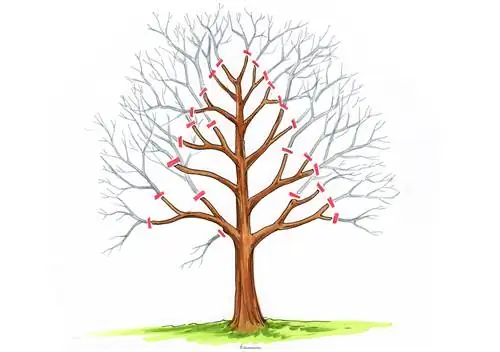
When rejuvenating a hornbeam crown, cut all leading branches back by half. Remove dead wood and branches in unfavorable positions on Astring.
Background
Cut thick branches in stages - correct cutting technique briefly explained
An old hornbeam sometimes confronts the gardener with a thick, old branch that needs to be removed. Sawing in one go runs the risk of the mighty branch breaking off and leaving an irreversible wound on the tree. With the right cutting technique you can prevent the accident from happening. First saw the branch from the bottom to the middle at a distance of 40 centimeters from the actual cutting point. Then move the saw to the right or left to saw from above until the branch breaks off. Support the stump with one hand while you cut the piece on a string.
Build up the hornbeam bush gradually
With annual growth of 30 to 35 centimeters, a hornbeam shrub grows far too quickly to become densely branched. It is important to slow down the growth rate and redirect plant energy into lower-ranking buds. This is achieved with agradual build-up cut A conical cut profile with a wide base and narrow crown makes an important contribution to letting in light deep into the interior of the bush so that photosynthesis can take place there and the leaves sprout. This is how you complete the perfect build-up cut on the hornbeam bush:
- On the day of planting, cut back all shoots by a third or half
- Prune every year in February to the desired final height
- Prune vigorous varieties again at the end of June
- Short last year's growth down to a remaining 5 to 10 centimeters
- Always cut at a short distance to an outward-facing bud
- Prune the shrub in a pyramidal shape with a slightly wider base and narrowed crown
The recommendedgradual education up to the final height puts the growth law of top support into practice. This law means that the hornbeam, like almost all plants, grows strongest at its shoot tips. Top buds are preferentially supplied with energy in order to grow as quickly as possible to light. The further a bud is from the tip position, the slower the growth. By continuously removing tip buds with a build-up cut, eyes positioned lower down benefit from the increased sap pressure and sprout. It follows that reduced height growth automatically results in increased sprouting of side branches.
In addition to the successive pruning, we recommend acutting profile in a pyramid shape for your hornbeam bush. In this way, sunlight reaches deep into the center of the tree because the branches do not shade each other. The reward for your caution is a dense foliage without any baldness from the inside out.
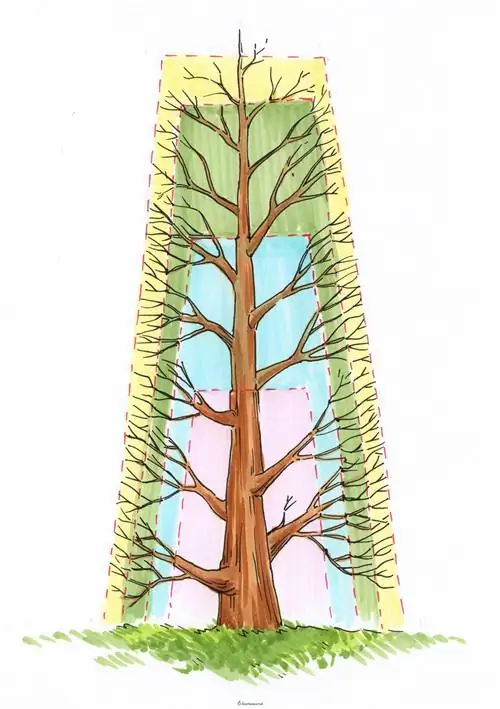
Stepwise training with a conical cutting profile is rewarded with a wind-stable, bushy, branched hornbeam bush. Prune last year's growth to 10 centimeters. Prune vigorous varieties again at the end of June. Continue the build-up cut to the final height.
Hornbeam bush - beautiful thanks to the thinning cut
Successful hornbeam varieties decorate the garden as a solitary shrub or small group. The pyramid hornbeam 'Fastigiata' impresses with its columnar silhouette and impressively lines driveways and avenues with a height of up to 15 meters. Its little sister, the columnar hornbeam 'Frans Fontaine', grows to a height of 6 to 8 meters and adorns the front garden as a slender foliage beauty. When placed alone, awell-behavedhornbeam bush remains beautiful if you cut it at leastonce a year If necessary, use scissors again at the end of June to control growth. How to cut correctly:
- The best time for the central thinning cut is in February
- Cut out dead, weak and annoying branches
- From the final height reached, cut off the previous year's growth
- Important: Pay attention to the cut on outward-facing buds
- Maintain tapered cutting profile
If a hornbeam is growing heavily in early summer, give the shrub a pruning treatment between the end of June (St. John's Day) and mid-July. Inspect the wood in advance forbreeding birdsIf you find what you are looking for,postpone the cutting time to August. Cut this year's growth back to an outward-facing leaf or bud.
Excursus
Electric shrub shears leave battered leaves behind
The hornbeam impresses with its decorative foliage. Its deciduous, egg-shaped to elliptical leaves are eight centimeters long and five centimeters wide. With bright golden yellow autumn colors, the deciduous tree rounds off the garden season magnificently. To ensure that the decorative foliage survives a cut without injury, mechanically operated shrub shears are out of place. Hornbeam leaves can become hopelessly tangled in the knife bars running against each other, are torn and are left with brown leaf edges for the rest of the year. Please always cut a hornbeam tree, shrub or hedge with one-handed or two-handed scissors.
Cut the hornbeam hedge twice a year
A gradual pruning, as described for the solitary shrub, is also beneficial for a hornbeam hedge. When the final height is reached, the pruning care culminates in regular shape and care pruning. It is cut at leasttwice a year, regardless of what phase of life the hedge is in. This is how an exemplary hedge trimming works:
- Cutting dates: February, June and optionally August
- Thimout dead wood at the beginning of February
- Stretch up cords first as a guideline for atrapezoidal cutting profile
- Up to the final height of the hedge: cut back previous growth to 5 or 10 centimeters
- From final height: completely blend previous growth
- Optional in August, cut back all branches that protrude from the hedge shape
Please carefully inspect the hedge for wintering or breeding birds before each cut. If you find what you are looking for, the cut will be postponed until later. It is easy to prune a hornbeam hedge in mid-August when breeding is over. The hedge trimmer should rest from the beginning of September so that shoots mature in time before the first frost.
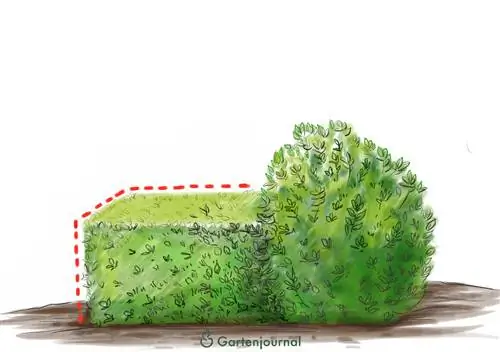
Formal hornbeam hedges are cut into shape in February and again at the end of June to mid-July. Stretched cords mark the advantageous trapezoidal shape for light-flooded growth.
Tip
Would you like to deepen your knowledge of cutting a hornbeam as a hedge? Then we recommend our comprehensive tutorial for the perfect hedge trimming. Here you can read well-founded instructions on the construction, care and rejuvenation of an opaque, shapely hornbeam hedge.

Rejuvenate aged hornbeam bushes
Failed pruning leaves its mark on hornbeam bushes. Within a few years, the deciduous trees as a solitary plant or hedge turn into an unsightly and impenetrable bush. It is now too late for subsequent maintenance cutting and too early for clearing. With a rejuvenation cut you can revitalize the hornbeam and then initiate the rebuilding process. The risk of a total failure is significantly minimized if you proceed intwo stages. How to do it right:
- The best time for each cutting stage is in winter on a frost-free day
- First step: Shorten the crown and one side to a quarter of the desired final height and width
- Second step: cut back uncut areas
- Cut back growth on the bush or hedge area that was rejuvenated last year to 10 centimeters
- After each pruning, fertilize with compost and horn shavings
From the third year onwards, you can rebuild rejuvenated hornbeam bushes as a solitary plant or hedge. Proceed gradually, leaving no more than 10 centimeters in height and width each year. By the end of June, the shoots from the first pruning stage will be so strong that you can start pruning on these areas. By mid-July, cut back the new growth to a remaining 5 or 10 centimeters. In early summer after the second rejuvenation stage, the pruning includes all shrub and hedge areas.
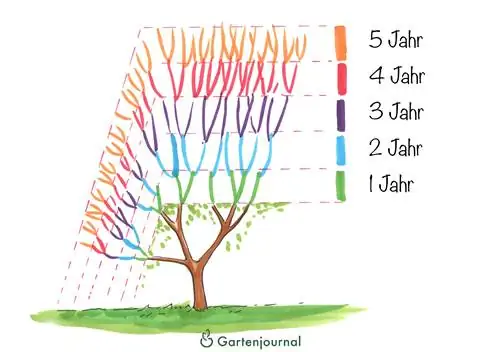
Large, old hornbeam bushes and hedges are gently rejuvenated over a period of two years. In the first year, cut back the crown and one side by three quarters. In the second year, shorten the opposite side and the hedge flanks. Following this, the cutting care is dedicated to a new structure.
Background
Radical pruning takes place in winter so that spring does not fall silent
No one can turn a blind eye to the dramatic population situation of our breeding birds. The many causes for the unabated decline include uncontrolled pruning in the middle of the breeding season. The Federal Nature Conservation Act puts a stop to this. Between1. March and September 30thPruning measures on trees and bushes are prohibitedprohibited Thinning, putting on a stick and other radical cuts are permitted from October 1st to February 28th provided that there are no wild animals in the woods. Light maintenance pruning may be carried out during the summer closed season, provided there are no bird nests in the wood and the pruning is limited to this year's growth.
Frequently asked questions
Is the hornbeam poisonous?
No, there are no toxic substances in a hornbeam. There are no toxins in the leaves, shoots and roots, nor in the flowers, seeds and fruits. The popular hedge plant also poses no danger to animals. The hornbeam is an excellent choice for enclosing properties, gardens, paddocks and pastures.
Can I train a young hornbeam to become a standard tree myself? If so, how does it work?
You can easily train a young plant to become a standard tree. Choose the strongest shoot and place a support post next to it. Connect the shoot and support with soft tubular ties that do not cut into the young bark. Cut off all vertical competing shoots at ground level. Side shoots along the future trunk are also removed. Guide the central shoot up its support to a height of 2.20 to 2.50 meters. Now shorten the tip, whereupon the branching to the crown begins. The hornbeam forms a beautiful crown from trunk extensions and 4 to 6 evenly arranged leading branches. Please cut off any branches that sprout below the crown.
Is the columnar hornbeam suitable for keeping in a large container?
Keeping a hornbeam in a container is not a problem if an optimal supply of water and nutrients is guaranteed in the summer months. During the cold season, pay close attention to ensure that the soil does not dry out. Furthermore, there is only limited frost tolerance in the pot. It is absolutely necessary that you cover the bucket with foil, fleece or a potato sack and push a wooden block under the bottom.
For my garden I am planning a narrow, approximately 50 centimeter wide hedge made of pyramidal hornbeams. Is the 'Fastigiata' variety suitable for this? How many plants are needed for 1 meter?
The excellent pruning tolerance of hornbeams allows them to be cultivated as narrow hedges. If you prune regularly, you can shorten pyramidal hornbeams to a width of 30 to 50 centimeters. For this purpose, trim the hedge two to three times a year, in February, at the end of June and, if necessary, a final time in August. When planting hedges, we recommend 3 plants per meter.
Nursery schools offer the hornbeam as a wintergreen shrub or tree. Does this mean that the plant retains its foliage over the winter?
Local site conditions have a significant influence on how long a hornbeam bears its leaves. In wind-protected locations, the leaves usually fall from mid-late December. The omens for long-lasting leaves are good if mild weather with sufficient moisture dominates in autumn. In dry autumn weather, we recommend continuing to water regularly and abundantly so that the foliage is not shed due to drought stress.
My freshly planted hornbeam hedge should be 2 meters high. Currently, at the beginning of July, the bushes have grown 1 to 1.50 meters high with quite thin tips. Can I cut the hedge back to 80 centimeters or do I have to wait until the final height is reached before cutting back?
The earlier pruning of a hornbeam hedge begins, the more densely the bushes will branch. We recommend that you prune promptly to promote branching in the lower hedge area. July is a good time to prune, as long as you don't prune in high heat or under direct sunlight.
The 3 most common cutting mistakes
If the hornbeam becomes a nuisance with its bare, misshapen silhouette, the gardener has made a pruning mistake. So that you can enjoy the well-groomed appearance of your tree, shrub and hedge for a long time, the following table draws attention to the three most common mistakes in pruning care and gives helpful tips for prevention:
| Cutting errors | malicious image | Prevention |
|---|---|---|
| never photographed | premature aging, impenetrable undergrowth | cut out dead wood regularly |
| put on the stick in one go | Total failure | rejuvenate in two or three stages |
| cut with electric scissors | battered foliage, brown leaf edges | Cut hornbeam manually |
Tip
Hornbeams form a symbiotic community with mycorrhizal fungi, which is beneficial for both sides. The result is that bare-root young plants hardly grow in the first few years because the symbiosis initially establishes itself underground. It is advisable to purchase a large hornbeam as a tree or shrub including the root ball in a container.

